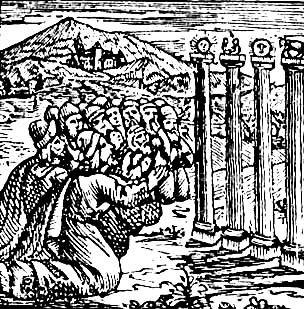
Fanciful woodcut above shows Hebrews worshipping the Sun, Moon and stars atop four aniconic Asherim. This blog will sooner or later get to a more probable iteration.
Citation compiled from Encyclopædia Britannica-
The word Asherah (Ashera, Asherim [plural]) in the [Hebrew Scripture] was used not only in reference to the goddess herself but also to indicate a wooden cult object associated with her worship. Prior to the conquest of Canaan (Palestine) by the Israelites in the 12th-11th century BC, the high places (Hebrew BAMAH, OR BAMA, Israelite or Canaanite open-air shrine usually erected on an elevated site) served as shrines of the Canaanite fertility deities, the Baals (Lords) and the Asherot (Semitic goddesses). In addition to an altar, matztzevot (stone pillars representing the presence of the divine) and asherim (upright wooden poles symbolizing the female deities) often were erected on the high places, which sometimes were located under a tree or grove of trees.
Because the Israelites had associated the divine presence with elevated places (e.g., Mount Sinai), they used Canaanite high places to worship their own God, Yahweh. Canaanite agricultural fertility rites and practices were adopted by the previously nomadic Israelites, often in a syncretic fashion with Yahweh replacing Baal. A strong reaction to the adoption of such rites led to protests by Israelite judges and prophets from the 12th to the late 7th century BC, when the Deuteronomic Reform of 621 bce led to the extirpation of the many local high places which included stone pillars, wooden Asherim and altars as sites of worship.
© 1994-2001 Encyclopædia Britannica, Inc.
from Edward Carpenter, 1914: As to the Asherah, or sometimes plural Asherim, translated "grove,"--for which the women wove hangings--the most generally accepted opinion is that it was a wooden post or tree stripped of its branches and planted in the ground beside an altar, whether of Jehovah or other gods. Several biblical passages, like Jeremiah ii. 27, suggest that it was an emblem of Baal or of the male organ, and others (e.g., Judges ii. 13, and iii. 7) connect it with Ashtoreth, the female partner of Baal; while the weaving of hangings or garments for the "grove" suggests the combination of female with male in one effigy. At any rate we may conclude pretty safely that the thing or things had a strongly sexual signification.
Intermediate Types among Primitive Folk by Edward Carpenter, pg 34 [1914] LONDON GEORGE ALLEN & Co. LTD
And BEST article in the internet on Asher'ah and Her connections is Asphodel Long's "Asherah, the Tree of Life and the Menorah : Continuity of a Goddess symbol in Judaism?" presented in 1996 at the College of St. Mark & St. John, Plymouth, UK [w/ excellent bibliography!) I would only add to Ms. Long's connections the Priestly redactor's concerns re: Aaron's blooming Rod and other "power" staffs which populate the Hebrew Scripture.
Two excellent books on this question are:
Patai, Raphael The Hebrew Goddess. Wayne Univ. Press Detroit 1990 isbn: 0814322719
Hadley, J. M. The Cult of Asherah in Ancient Israel and Judah- Evidence for a Hebrew Goddess. Cambridge Univ. Press 1997 isbn: 0521662354
No comments:
Post a Comment